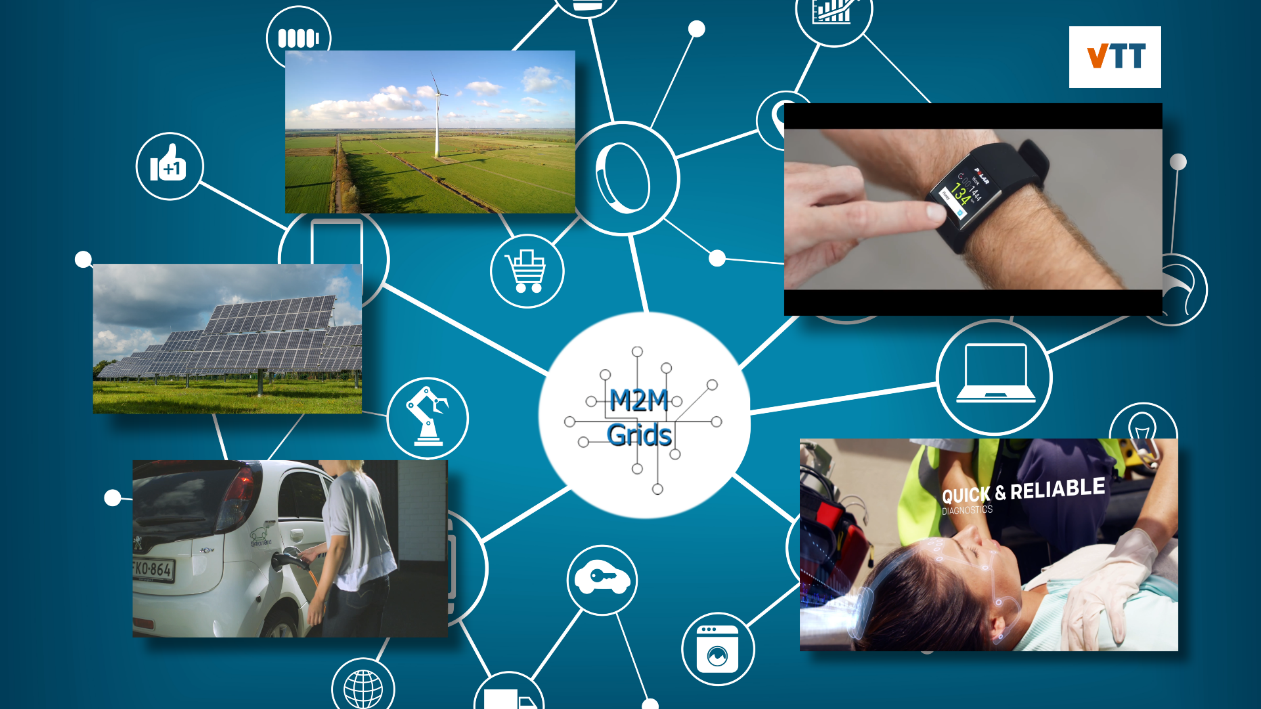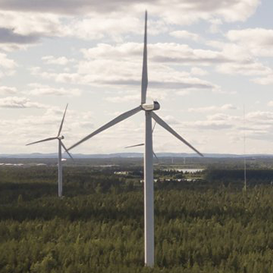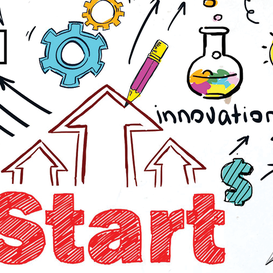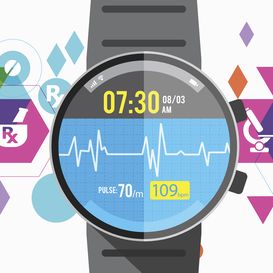M2MGrids
From vertical M2M silos towards smart interoperable Cyber-Physical Systems

Executed between November 2014 and May 2018, the M2MGrids project aimed at creating enablers for a dynamic cyber-physical information ecosystem that would interoperate in real time with the business processes of companies with real-life objects, people and things. The consortium was comprised of 29 partners from Belgium, Finland, Israel, the Netherlands, Portugal and Turkey, including 8 large enterprises, 14 SMEs and 7 academics. VTT acted as project coordinator while Nokia, from its research unit Nokia Bell Labs, acted as major industrial partner focused on M2M service platforms.
Major disruptions in energy and mobility domains
M2MGrids focused on major disruptions in targeted energy and mobility domains. The disruption in the energy domain was related to operating models and the high cost of peak hours in energy grids. To make more efficient use of the energy grid, there needed to be a flexible and automated means by which to control both consumption and generation between multiple energy stakeholders and prosumers. The inability of multiple stakeholder systems to exchange information in dynamic situations (such as in a traffic accident) was leading to disruptions in the mobility domain. Both focused cases demonstrated the need for collaborations between multiple vertical M2M silos, and implied opportunities for new types of services for real-time business processes via smart interoperable Cyber-Physical Systems. In addition, efforts to develop smart and interoperable cyber-physical systems were often hindered by vertical silos within M2M industries. A shift from use of vertical towards more horizontal capabilities, and from offline data analysis towards online operation was demonstrated, especially in the context of energy flexibility and traffic accident use cases.
The project developed a horizontal M2MGrids architecture framework, with a set of novel horizontal capabilities related to information models, algorithmic operation, stream processing, communication overlays, security, and specific capabilities of horizontal platforms that enable embedded products to be part of the cyber-world. These novel capabilities were evaluated in the energy flexibility and traffic accident use cases. More information can be found in the paper on the ITEA M2MGrids website.
Enablers

The demonstration of the energy flexibility use case included an evaluation of the World Wide Streams (WWS) horizontal service platform developed by Nokia Bell Labs. In the demonstration, WWS acted as a key horizontal enabler for a set of energy flexibility services interacting to balance the power level and reduce the peak loads in the distribution grid. The flexibility services combined a number of essential capabilities: Distribution system operators (DSO), network state monitoring and short-term congestion forecasting (Technolution, Target Holding, Alliander); a local energy flexibility market (Empower); scheduling of resources by aggregator services (Gecad); interaction with an aggregated simulation of energy resources like Electric Vehicles (EVs); buildings and local distribution grid (VTT); a standardised energy flexibility interface (EFI) for household appliances (TNO); an EFI-capable gateway for white goods (Arçelik, KoçSistem); and EFI-based operation of EVs (Eteration). The demonstration of the traffic accident use case included an evaluation of the virtual CPS communication hub (realised by VTT), which enables mobile embedded products and services of multiple stakeholders to horizontally interact and exchange information in a controlled and secure way. This CPS hub facilitated interaction between resources like a smart watch (Polar), a small air quality monitoring sensor (Imec), a wearable platform for health monitoring & analysis service (Bittium), a street lamp (Valopaa), animal tracking products (Tracker), a 3D camera (Sony), a crime announcement service (LiveU), and Safax authorisation service (TU/e). In addition, the CPS hub was the key enabler of the interaction with Nokia WWS, energy market service (Empower), external aggregation of simulated energy resources of EVs, buildings and local distribution grid (VTT).
The Nokia World Wide Streams (WWS) platform, as matured for distributed multi-actor automation scenarios in M2MGrids, is now enabling a Nokia Enterprise business unit product, and is regularly used in customer trials.
The Nokia Enterprise TEPS (Transport, Energy and Public Sector) segment sales unit promotes WWS as an enabler for flexible launching of services as part of segment solution toolkits, notably for the sub-segment of Energy Flexibility Management and related Smart City and Utility services. In this way, WWS is consistently broadening the capabilities of the Nokia IoT solution umbrella, with the management of distributed edge stream processing services, and facilitating domain expert service authoring on the platform. Being actively proposed in customer solutions in the energy domain and other automation domains alike, as well as in related smart city cases, WWS, already today, can be considered to enable a 20-30% higher business growth in application-enabling Digital Value Platform (DVP) projects for these segments worldwide.
New business models, new products
Empower IM analysed new business models for microgrid trading and networked devices in the M2MGrids project. This knowledge has led to activities for preparation of national infrastructure for energy flexibility in Finland targeted to new flexibility markets with national TSOs and local DSOs of the energy ecosystem.
Within the M2MGrids project Bittium created a Medical Analysis cloud (‘MA-Cloud’) solution, which was the basis for Bittium’s neurology businesses in the Medical business area. After the M2MGrids project, Bittium continued with the MA-Cloud solution from the research project to the commercialisation project. Today Bittium BrainStatus™ Wireless EEG Amplifier solution is medically certified and together with Bittium MedicalSuite™ Service Platform (formerly called MA-Cloud) these solutions are generally available to domestic and international customers. Bittium BrainStatus™ is a wireless compact EEG amplifier, which is used together with a disposable easy and quick to wear Bittium BrainStatus™ electrode headband for diagnosing patients with altered mental status like status epilepticus. Bittium BrainStatus™ enables quick measurement in field conditions as well as in hospitals, thus making the treatment process of the patient faster. Tracker developed a low-power development platform for new products, applications and services for monitoring, tracking and control in M2MGrids. The platform led to the development of the Tracker Artemis product, the world’s first 4G IoT dog tracking collar, which is now generally available. Commercialisation impact estimation including device and related services sales is about €3 m in 2020. The development is essential in Tracker growth, and four persons were employed permanently even after the project, with market share potentially increasing in future.
M2MGrids contributed to the development of smartness and interoperability for cyber-physical systems, especially in energy and mobility domains.
Technolution developed a sensor prototype for sensing power quality as well as congestion analysis and prediction in M2MGrids. After the project, this R&D led to the Technolution LS/MS sensor product, which is now offered in different markets for non-intrusive, cost-effective and high-quality sensing, such as low/midvoltage power cables and industrial electrical motors. The sensor products have been installed as part of a multi-purpose sensing platform in multiple sites, such as energy grid transformers, steel factories and industrial machinery electrical motors, helping these clients track and predict the status of their processes, equipment, infrastructure and equipment status in realtime. The development of the LS/MS sensor, partly within M2MGrids, has proven to be a key feature in the Technolution IoT operation and management portfolio.
Slimmer AI (formerly Target Holding) developed machine-learning knowledge of short-term energy consumption forecasting from daily down to 15-minutes horizons (called nowcasting) within M2MGrids. This knowledge has boosted the development of new, AI-powered forecasting and balancing solutions for energy producers and solar panel companies, including day-tonight storage, for solving problems pertaining to grid congestion. Besides this direct exploitation, the forecasting technology is part of Slimmer’s AI toolbox. It is further developed and adapted to a number of other applications. Working closely with its customers, Slimmer AI expects to employ up to 10 colleagues on the basis of this M2MGrids technology within three years.
Arcelik was first to introduce new, automated demand/response compatible household appliance products. KoçSistem exploited the results to enable energy management of adaptive demand-supply household and industry devices as well as energy grid adaptive demand-supply gateways. Eteration developed a Complex Event Processor that manages real-time events within big data according to the execution plans. The processor can run in embedded gateways and large-scale cloud environments. Imec has taken advantage of the project’s work by producing an Air Quality Monitoring Platform that provides real-time monitoring/accessing of the sensing data along with data storage in the cloud. LiveU has opened significant market opportunities, having won a tender for the next Olympic games with the Japanese police department and also having collaborated with Associated Press on a new live video exchange newsgathering platform: AP Live Community, an app based on M2M.
Vertical to horizontal shift
The M2MGrids project contributed strongly towards shifting from vertical use towards more horizontal capabilities in the IoT product development. It also contributed to the development of smartness and interoperability for cyber-physical systems, especially in energy and mobility domains. Despite the huge challenge, the M2MGrids project succeeded in making real progress as is evident by the exploitation of the novel solutions created during the project. In addition, several new research opportunities were identified during the project and these have led to the preparation of EU-wide research and national coinnovation projects including e.g. INTERRFACE (flexibility markets), TIoCPS (trustworthy communities), iFLEX (end-user perspective for flexibility markets) and OneNet (scaling of flexibility market mechanisms).
More information
Other articles
Use the arrows to view more articles

Editorial
By Philippe Letellier

Country Focus: Finland
Leapfrogging into the future

Empower IM Oy
Empowering the digital energy economy

Online ITEA Project Outline Preparation Days 2020
We look forward to connecting (with) you!

ITEA Success story: SCALARE
Systematic guidance to decision makers for scaling scenarios

Community Talk with Robyn Woods
and a panacea for care

End user happiness: eWatch
Extensive health monitoring platform

SME in the spotlight: Cyclomedia
Where seeing is believing

ITEA Success story: M2MGrids
From vertical M2M silos towards smart interoperable Cyber-Physical Systems

Practise what you preach
The story of a Cluster’s quality system

Collaborative, automated and trusted
Future methodologies for effective cybersecurity

Introducing the ITEA 3 Call 6 projects
A Community in motion


